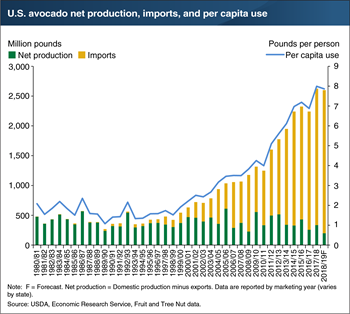
Posts Tagged: fruits
USDA Forecasts for Avocado And Citrus and .....
Here's an example of the kind of information that can be both exciting and disappointing - forecasts of the future of the citrus and avocado industries and many other fruit and nut crops. The latest forecasts are available form the USDA - Economic Research Service:
https://www.ers.usda.gov/webdocs/publications/92731/fts-368.pdf?v=7239.3

Wednesday, April 24, 2019
Imports play a significant role in meeting the U.S. demand for avocados. Since the mid-1990s, imports of avocados have grown sharply as per capita consumption has grown, representing 87 percent of domestic use in the 2017/18 marketing year. USDA forecasts that imports will make up an even larger share of supply in 2018/19, mainly because California's crop is expected to be smaller than in recent years. Contributing factors to this reduced crop include record-breaking heatwaves in July 2018 followed by record-breaking wildfires, as well as recent rains and cold weather, and the general alternate-year-bearing nature of avocado trees (whereby a large crop one year is followed by a smaller crop the next year). Because over 80 percent of all U.S.-produced avocados each year are from California, California's low harvest in 2018/19 should boost U.S. demand for imported avocados (especially from Mexico) even higher than it has been in recent years. If USDA's forecast is realized, imports in 2018/19 will represent 93 percent of the domestic avocado supply. This chart appears in the ERS Fruit and Tree Nuts Outlook newsletter, released in March 2019.
Fruit & Tree Nuts
Provides current intelligence and forecasts the effects of changing conditions in the U.S. fruit and tree nuts sector. Topics include production, consumption, shipments, trade, prices received, and more.
https://www.ers.usda.gov/webdocs/publications/92731/fts-368.pdf?v=7239.3
Can the past foretell the future?

avocado grower 1910
California Testing Finds Little or No Pesticide Residues on Most Fruits and Vegetables in 2015
|
Out of 3,600 samples of 145 fresh fruits and vegetables tested in California in 2015, just 43 had pesticide residue over legal limits, and 113 contained residue of a pesticide not approved for that commodity. Pesticide residue limits are set based on legal use of the product and violations are generally not health concerns.? The tests were conducted by the California Department of Pesticide Regulation, which for three decades has been conducting one of the most comprehensive pesticide monitoring programs in the country. Other highlights from the just-released results:
As in recent years, the majority of these samples had residues at less, usually much less, than 10% of the tolerance level. The department also tested 170 fruits or vegetables labeled organic and 85.3% had no detectable pesticide residue, 11.8% had residues acceptable under organic regulations, 2.4% had residues acceptable in conventionally grown produce but not organic, and 0.6% had unacceptable residues. Certain products from China and Mexico had the highest level of illegal pesticide residues detected.
|
The Top Ten Blogs for Topics in Subtropics
Here are the top 10 blogs from Topics in Subtropics over the last 5 years. The two earliest and latest pertain to how you select products that will truly help you from amongst all those that are being promoted. Some of these have been around a long time, so that's why they are the most read. Do a Ctrl + click on the URL to read the post.
Title Author Date
A predatory mite

predatory mite
California Agricultural Production Statistics
California agriculture experienced a nearly three percent increase in the sales value of its products in 2012. The state's 80,500 farms and ranches received a record $44.7 billion for their output last year, up from $43.3 billion in 2011 and $37.9 billion during 2010. California remained the number one state in cash farm receipts with 11.3 percent of the US total. The state accounted for 15 percent of national receipts for crops and 7.1 percent of the US revenue for livestock and livestock products. Exports totaled $18.18 billion in value which represents an eight percent increase over the previous year.
California's agricultural abundance includes more than 400 commodities. The state produces nearly half of US-grown fruits, nuts and vegetables. Across the nation, US consumers regularly purchase several crops produced solely in California.
California's top-ten valued commodities for 2012 are:
- Milk — $6.9 billion
- Grapes — $4.449 billion
- Almonds — $4.347 billion
- Nursery plants — $3.543 billion
- Cattle, Calves — $3.299 billion
- Strawberries — $1.939 billion
- Lettuce — $1.448 billion
- Walnuts — $1.349 billion
- Hay — $1.237 billion
- Tomatoes — $1.170 billion
Please see complete statistics for 2012, reproduced as PDF files below, or use the link in the right column to access this report and others on the NASS website.

workers
UC Hansen Agricultural Research and Extension Center celebrates National Nutrition Month
March is National Nutrition Month. To celebrate what healthy food is and where it comes from, the Center held its 3rd Annual Preschool Open House—Healthy Foods Start on the Farm, on March 5th. Over 200 Ventura County preschoolers and their families...
